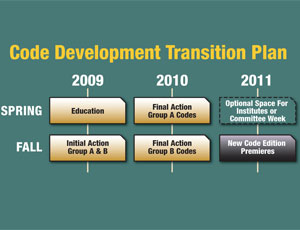Members of the International Code Council are all over the map about the revamped model code development process announced by the publisher of the widely adopted International Building Code and a dozen other model codes. Many greet the change with open arms, saying it will streamline the process. Others think the new process will stifle innovation, reduce the quality of the codes and allow special interests to more easily hijack the development process.


The biggest change is that there will be one complete code development cycle every three years instead of two. A consequence of that is elimination of the interim supplement, published 18 months after the “I-Codes.” Tom Frost, senior vice president, technical services, in the Country Club Hills, Ill., office of ICC, says, “The supplement was published as a convenience for participants to keep track of the code's evolution. It was rare for jurisdictions to adopt it.”
The Washington, D.C.-based ICC is primarily responding to member concerns about lengthy code development hearings, twice a year, that can last 12 hours a day and fill two weeks. Of ICC’s 42,000 members, some 5% attend hearings where voting takes place.
Jeri L.S. Morey, an architect in Corpus Christi, Texas, speaks for others by saying she is “delighted” with the new process.
Starting with the 2015 edition, code development will be split into two groups of codes. Initial action for one group will be in spring 2012 with final action in the fall. Initial action and final action for the second group will be a year later. There will be one only chance per cycle to submit a change proposal. The codes and most of the commentary will be produced in the third year of each cycle. The 2015 edition will be ready for the annual business meeting in fall 2014.
The code development hearings will be at the same location for each cycle; final action hearings will be held in conjunction with the annual business meeting. Barry Gupton, chief code consultant for North Carolina Dept. of Insurance, Raleigh, is for the change “in principle” but concerned that code development hearings at the same location could lead to regional bias. Others are concerned it will be easier for special interests to pack code hearings with like-minded voters and derail a proposal.
The death of the supplement is welcomed by some, who say it is confusing. Others find the supplement process of value. If something inappropriate “slipped” into the code, the supplement could amend it out, says Randy Melvin, director of research and standards, Winchester Homes Inc., Bethesda, Md.
Jonathan Siu, principal engineer-building official for Seattle Dept. of Planning & Development, is strongly against the change. He predicts the code will become static and innovation will be stifled. “It will be easy to derail code change proposals that don’t have appropriate language, regardless of whether or not concepts are good,” says Siu. One cycle will result in a poorly written code, which will lead to inconsistent interpretation and enforcement problems, he adds.
Several parties see a downside to splitting the codes into two groups. One concern is coordination and the other is the expense of having to prepare for and attend hearings for both groups.
Code change proposals for the 2012 “transition” edition are due on April 24. There will be a fall meeting in Baltimore for initial action, followed by separate final action hearings next year. Details are available at www.iccsafe.org.
John D. Hooper, a principal with structural engineer Magnusson Klemencic Associates, Seattle, is concerned about the transition. “The timing is going to cause significant challenges” to the standards development and professional organizations that created their schedules based on the old timetable, he says. “Important changes may not be completed by the April 24 deadline,” he says. An example are newer earthquake ground motion maps from the Building Seismic Safety Council.
“Change always creates new challenges and opportunities,” says Robert J. Willis, a vice president of the Steel Market Development Institute, Washington, D.C. The steel sector is ready to work with ICC to make the transition, he adds.


Post a comment to this article
Report Abusive Comment